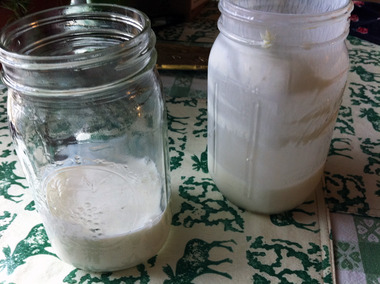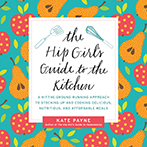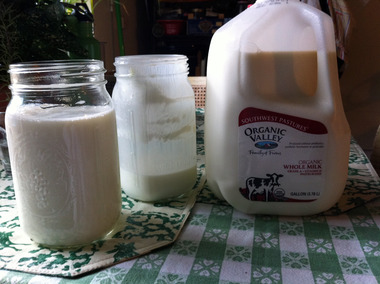Make your own buttermilk
 My friend Julia is always up to cool stuff. Turns out Julia and I had a mutual friend (whom we’re both very close to), and discovered this after we met via blogland last year. When I finally met Julia in real life (IRL, if you will) I got to meet her adorable, charming kiddo and pick strawberries (my first time in a strawberry patch) all in one!
My friend Julia is always up to cool stuff. Turns out Julia and I had a mutual friend (whom we’re both very close to), and discovered this after we met via blogland last year. When I finally met Julia in real life (IRL, if you will) I got to meet her adorable, charming kiddo and pick strawberries (my first time in a strawberry patch) all in one!
Julia turned me onto the notion that I could stop spending $4 every time I encounter a recipe that calls for buttermilk. Her post (and nod to her own inspiring friend) tells you everything you need to know. I’ll share with you how I’ve managed to do it.
You’ll start out buying one more carton of buttermilk to get things going (you need those bacteria cultures), but after this, you shouldn’t ever need to buy another!
You could always start your own buttermilk cultures, but I don’t know how to do that yet, so I can’t tell you how easy or challenging that might be. [I have a hunch that it’s not very hard at all; yogurt- and cheese-making is on my 2011 how-to learning list.]
DIY buttermilk recipe
yields 1 quart jar
1. I use a freshly-washed quart jar and lid.
2. Fill jar to the 8oz-marker (1 cup) with existing, cultured buttermilk. (Make sure you buy ‘cultured buttermilk’)
3. Pour regular (hopefully organic) milk to fill the rest of the jar. Use whatever fat percentage you have. Mine is whole milk, but any will do.
4. Wipe any spills from around the rim and add a lid. Place it on your kitchen counter or in a cupboard for 24 hours.
The next day, give it a good shake and discover gleefully that it has thickened up (thank you good bacteria!), and then place it in the fridge. I’ve found that mine lasts pretty much indefinitely, though you should probably use it within a month. Shake well before every use.
5. As your buttermilk supply dips lower in your jar, reserve 8 oz for your next batch. Use a clean jar and repeat the process!
Note: If you wait too long to make another batch (more than a month), your cultures might not be as potent. If you notice a still-quite-liquid milk after you’ve had it out for 24 hours, try adding a dollup of sour cream and let that sit out until it thickens. Sour cream shares the same microbes as buttermilk, and will help kick your jar into gear.
You’ll be surprised at all the delicious things you come up with when you have buttermilk on hand to use up. I made these gluten-free orange vanilla buttermilk muffins yesterday morning as a result of a surplus that needed to be moved along. Recipe to come, stay tuned!
Read on and check out the great comments below for tips on what to use in lieu of buttermilk in a pinch and other creative ideas for using up your buttermilk.





 Monday, January 24, 2011 at 8:07AM
Monday, January 24, 2011 at 8:07AM

Reader Comments (12)
Awesome idea! I always need buttermilk but I usually just substitute 1 tablespoon lemon juice or white vinegar and fill up to a cup of milk. It works.
I've been experimenting with making my own cheese at home so this is right up my alley. Thanks for posting it.
That's so easy! I started making my own yogurt a few months ago and was amazed how easy it is. Now to find out buttermilk is so easy! I better go buy some and get started!
Those biscuits look DELICIOUS!!!!
Oh, yeah! It's the gift that keeps on giving fluffy baked goods! And thanks for the props on such a simple thing. I'm constantly inspired by you and what you accomplish! Giving thanks to the blogosphere and Ms. P!
If I just need a quick bit of buttermilk for a recipe, I usually use milk & rice wine vinegar - not quite as sharp as white vinegar, and not as distinct as lemon. Mostly, I use buttermilk I've saved from making butter. Like you, I'm planning to get more into making yogurt and cheese this year, but I have been having great fun making my own butter for the last year and a half or so.
nice one! i love homemade buttermilk! and it's true, when you have it around the fridge, there is always something to make with it. i like to do lassis! :)
You can make sour cream this same way. I do that just before Christmas when I had a container of cream that was going to go bad before we got back from visiting relatives. Sour cream and buttermilk have a much longer shelf life.
It does get to be a challenge using up a whole jar of buttermilk every three weeks or so, though. Some people drink it, and of course you can make lots of cakes and muffins, but we needed to find some other options. I now use some to make loaves of buttermilk-oat bread for sandwiches and use it to marinade chicken. I sometimes throw lots of garam masala in the buttermilk and marinade the chicken before making curry, and the buttermilk really helps the spices get into the meat, not to mention tenderizing it.
Excellent! We use buttermilk for lots of things. Bread, pancakes, french toast and marinating chicken. I have been making yogurt using store bought yogurt as my starter for quite some time and never even thought to use buttermilk to make buttermilk. Thanks!
When I make paneer, I save the whey that drains away from the cheese - it can be used for buttermilk or milk in baking recipes (although I don't think I'd drink it or, say, cook oatmeal in it) and keeps for at least a month.
I was just thinking I'd look into making my own buttermilk and am thrilled to have found this easy method. I've done a lot of fresh cheese making. It's tons of fun. Definitely do it!
I was wondering if the lid matters? Should I buy those plastic lids that are for the mason jars or can I just use the regular metal lid and rims they come with? Thank you for this post, I am so excited about it.
Oh, you'll be so glad once you've tried this! I've been doing this for quite a while now, and when I buy the cultured buttermilk, distribute 1tablespoon portions into an ice cube tray - freeze it, and when you want to make buttermilk, put a couple of cubes in the bottom of a jar (I use pickle jars for buttermilk, peanut butter jars for yogurt,so we can tell them apart), pour milk in, and put the lid on - let stand at room temp for a day or two until it thickens - much, much easier than making yogurt! Make a few jars at a time, and when you start to run out of starter cubes, start over with some of your own buttermilk! I also freeze my yogurt "starter". Ziploks work best to store the frozen starter cubes, but if you're doing both buttermilk and yogurt, be sure to label them - they're awfully difficult to tell apart once they're frozen!